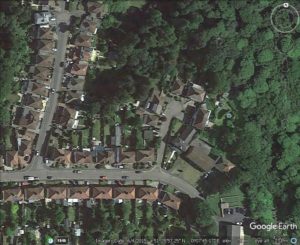‘Bexley Wildlife’ has been contacted by local residents opposing a plan to demolish numbers ‘5 and 6 Friars Walk to create access to a new development of 8 detached 2/3 storey houses (2×3 bed, 3x4bed, 3x5bed) with rear gardens backing to Abbey Wood, and new street, parking and landscaping at front”. It is being claimed by the ‘developer’ that the gardens are ‘wasted’ and of ‘no benefit’ to anyone, that there will be no adverse effect on protected or priority species either on or adjacent to the site, and that there will be no loss of trees, which looks dubious given the density of them indicated by aerial photographs. Approval would certainly be another unwelcome move regarding the future look and feel of our (for now) suburban Borough.

Friar’s Walk (right) for which an application has been submitted to Bexley Council to demolish two existing dwellings and build 8 new ones on what are currently gardens.
An opponent says ‘We are a tiny woodland close adjacent to Lesnes Woods. We are set to lose many old native trees, plus Bats, slow worms, Stag beetles and other species as a result of a proposed housing development in 3 large gardens. Tawny owls and other birds have already gone since clearance started …… (we) do our best to support the indigenous wildlife and love the tranquility of this natural woodland environment.’
Unfortunately none of these species enjoy sufficient legal protection to stop this sort of ‘development’ from going ahead on their own account. However, Bexley’s Core Strategy (the Council’s policy ‘bible’) says, at Policy CS17, 4.8.10 :
‘The natural environment, and particularly our open spaces and waterways are also rich sources of biodiversity and archaeology. Back land areas in the borough include gardens and incidental open space. They should normally be excluded from development where developments results in harm to amenity and biodiversity. Further details in this respect will be set out in future policy documents, such as a development plan document that deals with detailed sites and policies.
So in theory the Council has a policy against garden-grabbing and can legitimately turn the application down. The problem is that the Core Strategy is still the policy but is effectively a dead duck because the Council has decided to tear it up in favour of its much trumpeted ‘Growth Strategy’, at the heart of which (though it doesn’t say so very explicitly) is a target for a 20% growth in population. It laughably calls this a ‘Vision’. The reality is that it is kow-towing to Boris Johnson’s grand plan from when he was London Mayor. This involves what is politely termed ‘densification’ across the east side of London, which is essentially what this planning application is proposing. Whilst the ‘Growth strategy’ isn’t official policy yet, it will probably be touted as some kind of ‘agreed direction of travel’ in the meantime. Which position will win out in this case will therefore be a strong indication of what the future of our Borough is going to look like, irrespective of whether the Tories or Labour are in control as they both think all this ‘growth’ is unquestionably a ‘good thing’.
The ‘developer’ states that residents in the Walk have collaborated on this scheme (though the wording is ambiguous as to exactly how many of them), and that it is supported by the National Planning Policy Framework (but then that is skewed massively in favour of building everywhere). Very disturbingly, in terms of setting a future precedent if the application is approved, the proponents are advancing the argument that: ‘These gardens are evidently hugely disproportionate to the houses and must be so by historical accident and it is impossible for these houses to either fully utilise and enjoy on indeed maintain these gardens; an impossible and unreasonable task to ask from them. Clearly these gardens, therefore, represent a very ineffective use of private land in reality being wasted and of no benefit to anyone let alone the owners. In effect, and in accordance with the emphasis on the dire need for housing (especially in London) and on the most sustainable use of resources, and given they are of no public benefit they ought to be developed, admittedly by a development of special character given their wonderful location. They cannot be used or enjoyed in full by the occupiers who want to understandably develop them as they are enormous and a financial burden to them.’
The applicant further claims that ‘This proposal, by utilizing effectively currently huge neglected and underused private areas of no public benefit will not only make efficient use of this land – a key primary planning sustainability objective’. It is not obvious that this squares with providing an extra 21 parking spaces over what already exists. Nor does the size, location and likely sale price of the proposed dwellings suggest that the ‘development’ will do much to help those most in housing need.
We suggest that all ‘BW’ followers worried about the same thing happening on their patch start opening their gardens to the public with immediate effect ….. !

Bexley Council has been resisting moves this kind by refusing planning permission to build on garden land. In 2012 in Wansunt Road, Bexley (11/01937/FUL) and last year in North Cray – Honeyden Road (16/01237/FUL) and St James Way (16/00348/FUL). We wish our fellow residents in Friar’s Walk every success too. Jean Gammons, Secretary, North Cray Residents Association